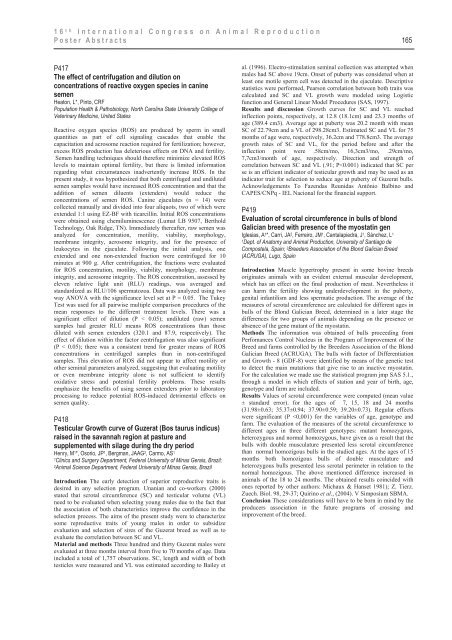Reproduction in Domestic Animals - Facultad de Ciencias Veterinarias
Reproduction in Domestic Animals - Facultad de Ciencias Veterinarias
Reproduction in Domestic Animals - Facultad de Ciencias Veterinarias
Create successful ePaper yourself
Turn your PDF publications into a flip-book with our unique Google optimized e-Paper software.
16 t h International Congress on Animal <strong>Reproduction</strong><br />
Poster Abstracts 165<br />
P417<br />
The effect of centrifugation and dilution on<br />
concentrations of reactive oxygen species <strong>in</strong> can<strong>in</strong>e<br />
semen<br />
Heaton, L*, P<strong>in</strong>to, CRF<br />
Population Health & Pathobiology, North Carol<strong>in</strong>a State University College of<br />
Veter<strong>in</strong>ary Medic<strong>in</strong>e, United States<br />
Reactive oxygen species (ROS) are produced by sperm <strong>in</strong> small<br />
quantities as part of cell signal<strong>in</strong>g casca<strong>de</strong>s that enable the<br />
capacitation and acrosome reaction required for fertilization; however,<br />
excess ROS production has <strong>de</strong>leterious effects on DNA and fertility.<br />
Semen handl<strong>in</strong>g techniques should therefore m<strong>in</strong>imize elevated ROS<br />
levels to ma<strong>in</strong>ta<strong>in</strong> optimal fertility, but there is limited <strong>in</strong>formation<br />
regard<strong>in</strong>g what circumstances <strong>in</strong>advertently <strong>in</strong>crease ROS. In the<br />
present study, it was hypothesized that both centrifuged and undiluted<br />
semen samples would have <strong>in</strong>creased ROS concentration and that the<br />
addition of semen diluents (exten<strong>de</strong>rs) would reduce the<br />
concentrations of semen ROS. Can<strong>in</strong>e ejaculates (n = 14) were<br />
collected manually and divi<strong>de</strong>d <strong>in</strong>to four aliquots, two of which were<br />
exten<strong>de</strong>d 1:1 us<strong>in</strong>g EZ-BF with ticarcill<strong>in</strong>. Initial ROS concentrations<br />
were obta<strong>in</strong>ed us<strong>in</strong>g chemilum<strong>in</strong>escence (Lumat LB 9507, Berthold<br />
Technology, Oak Ridge, TN). Immediately thereafter, raw semen was<br />
analyzed for concentration, motility, viability, morphology,<br />
membrane <strong>in</strong>tegrity, acrosome <strong>in</strong>tegrity, and for the presence of<br />
leukocytes <strong>in</strong> the ejaculate. Follow<strong>in</strong>g the <strong>in</strong>itial analysis, one<br />
exten<strong>de</strong>d and one non-exten<strong>de</strong>d fraction were centrifuged for 10<br />
m<strong>in</strong>utes at 900 g. After centrifugation, the fractions were evaluated<br />
for ROS concentration, motility, viability, morphology, membrane<br />
<strong>in</strong>tegrity, and acrosome <strong>in</strong>tegrity. The ROS concentration, assessed by<br />
eleven relative light unit (RLU) read<strong>in</strong>gs, was averaged and<br />
standardized as RLU/106 spermatozoa. Data was analyzed us<strong>in</strong>g two<br />
way ANOVA with the significance level set at P = 0.05. The Tukey<br />
Test was used for all pairwise multiple comparison procedures of the<br />
mean responses to the different treatment levels. There was a<br />
significant effect of dilution (P < 0.05); undiluted (raw) semen<br />
samples had greater RLU means ROS concentrations than those<br />
diluted with semen exten<strong>de</strong>rs (320.1 and 87.9, respectively). The<br />
effect of dilution with<strong>in</strong> the factor centrifugation was also significant<br />
(P < 0.05); there was a consistent trend for greater means of ROS<br />
concentrations <strong>in</strong> centrifuged samples than <strong>in</strong> non-centrifuged<br />
samples. This elevation of ROS did not appear to affect motility or<br />
other sem<strong>in</strong>al parameters analyzed, suggest<strong>in</strong>g that evaluat<strong>in</strong>g motility<br />
or even membrane <strong>in</strong>tegrity alone is not sufficient to i<strong>de</strong>ntify<br />
oxidative stress and potential fertility problems. These results<br />
emphasize the benefits of us<strong>in</strong>g semen exten<strong>de</strong>rs prior to laboratory<br />
process<strong>in</strong>g to reduce potential ROS-<strong>in</strong>duced <strong>de</strong>trimental effects on<br />
semen quality.<br />
P418<br />
Testicular Growth curve of Guzerat (Bos taurus <strong>in</strong>dicus)<br />
raised <strong>in</strong> the savannah region at pasture and<br />
supplemented with silage dur<strong>in</strong>g the dry period<br />
Henry, M 1 *, Osorio, JP 1 , Bergman, JAAG 2 , Carmo, AS 1<br />
1Cl<strong>in</strong>ics and Surgery Department, Fe<strong>de</strong>ral University of M<strong>in</strong>as Gerais, Brazil;<br />
2Animal Science Department, Fe<strong>de</strong>ral University of M<strong>in</strong>as Gerais, Brazil<br />
Introduction The early <strong>de</strong>tection of superior reproductive traits is<br />
<strong>de</strong>sired <strong>in</strong> any selection program. Unanian and co-workers (2000)<br />
stated that scrotal circumference (SC) and testicular volume (VL)<br />
need to be evaluated when select<strong>in</strong>g young males due to the fact that<br />
the association of both characteristics improve the confi<strong>de</strong>nce <strong>in</strong> the<br />
selection process. The aims of the present study were to characterize<br />
some reproductive traits of young males <strong>in</strong> or<strong>de</strong>r to subsidize<br />
evaluation and selection of sires of the Guzerat breed as well as to<br />
evaluate the correlation between SC and VL.<br />
Material and methods Three hundred and thirty Guzerat males were<br />
evaluated at three months <strong>in</strong>terval from five to 70 months of age. Data<br />
<strong>in</strong>clu<strong>de</strong>d a total of 1,757 observations. SC, length and width of both<br />
testicles were measured and VL was estimated accord<strong>in</strong>g to Bailey et<br />
al. (1996). Electro-stimulation sem<strong>in</strong>al collection was attempted when<br />
males had SC above 19cm. Onset of puberty was consi<strong>de</strong>red when at<br />
least one motile sperm cell was <strong>de</strong>tected <strong>in</strong> the ejaculate. Descriptive<br />
statistics were performed, Pearson correlation between both traits was<br />
calculated and SC and VL growth were mo<strong>de</strong>led us<strong>in</strong>g Logistic<br />
function and General L<strong>in</strong>ear Mo<strong>de</strong>l Procedures (SAS, 1997).<br />
Results and discussion Growth curves for SC and VL reached<br />
<strong>in</strong>flection po<strong>in</strong>ts, respectively, at 12.8 (18.1cm) and 23.3 months of<br />
age (389.4 cm3). Average age at puberty was 20.2 month with mean<br />
SC of 22.79cm and a VL of 298.28cm3. Estimated SC and VL for 75<br />
months of age were, respectively, 36.2cm and 778.8cm3. The average<br />
growth rates of SC and VL, for the period before and after the<br />
<strong>in</strong>flection po<strong>in</strong>t were .58cm/mo, 16,3cm3/mo, .29cm/mo,<br />
7,7cm3/month of age, respectively. Direction and strength of<br />
correlation between SC and VL (.91; P

















